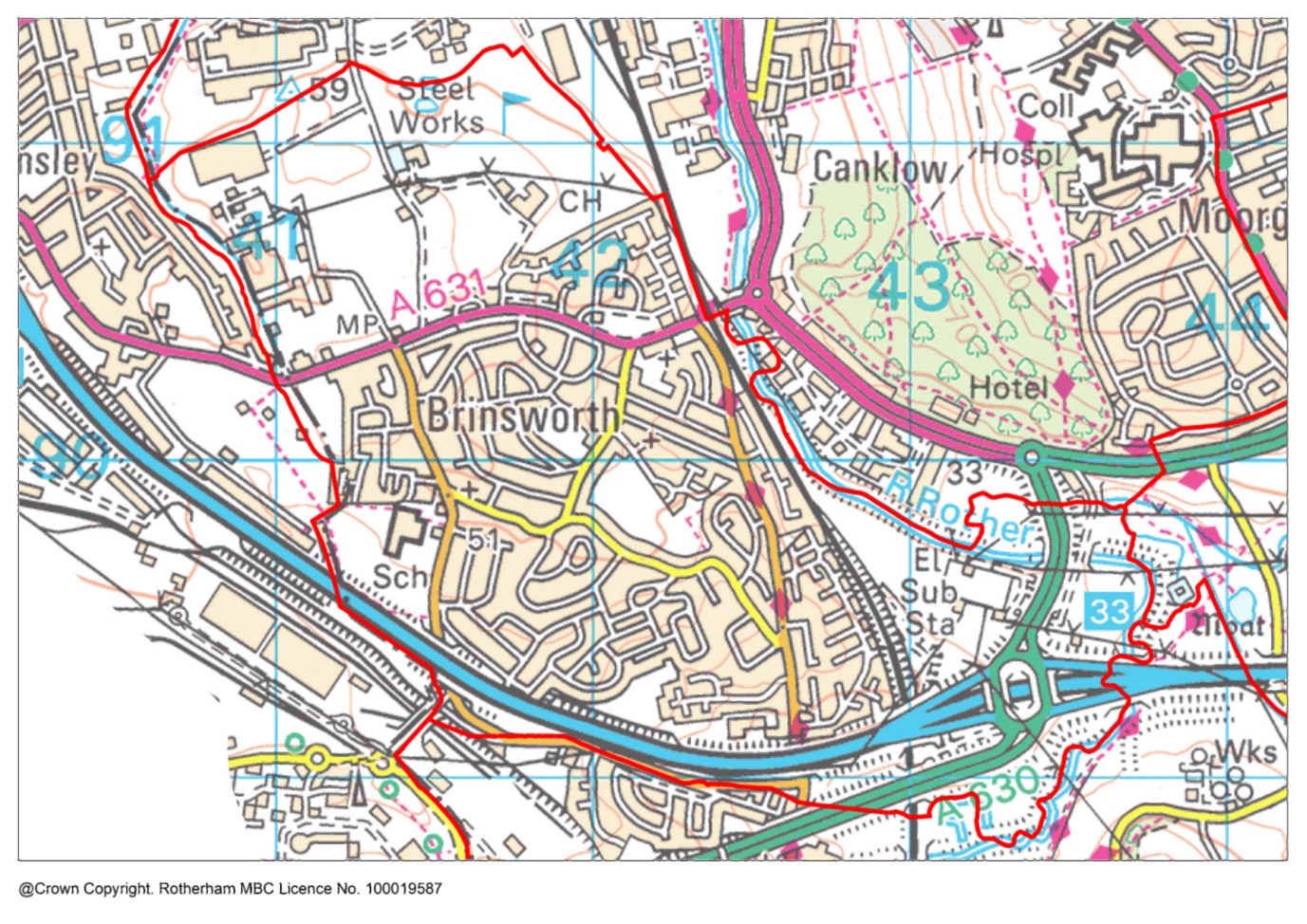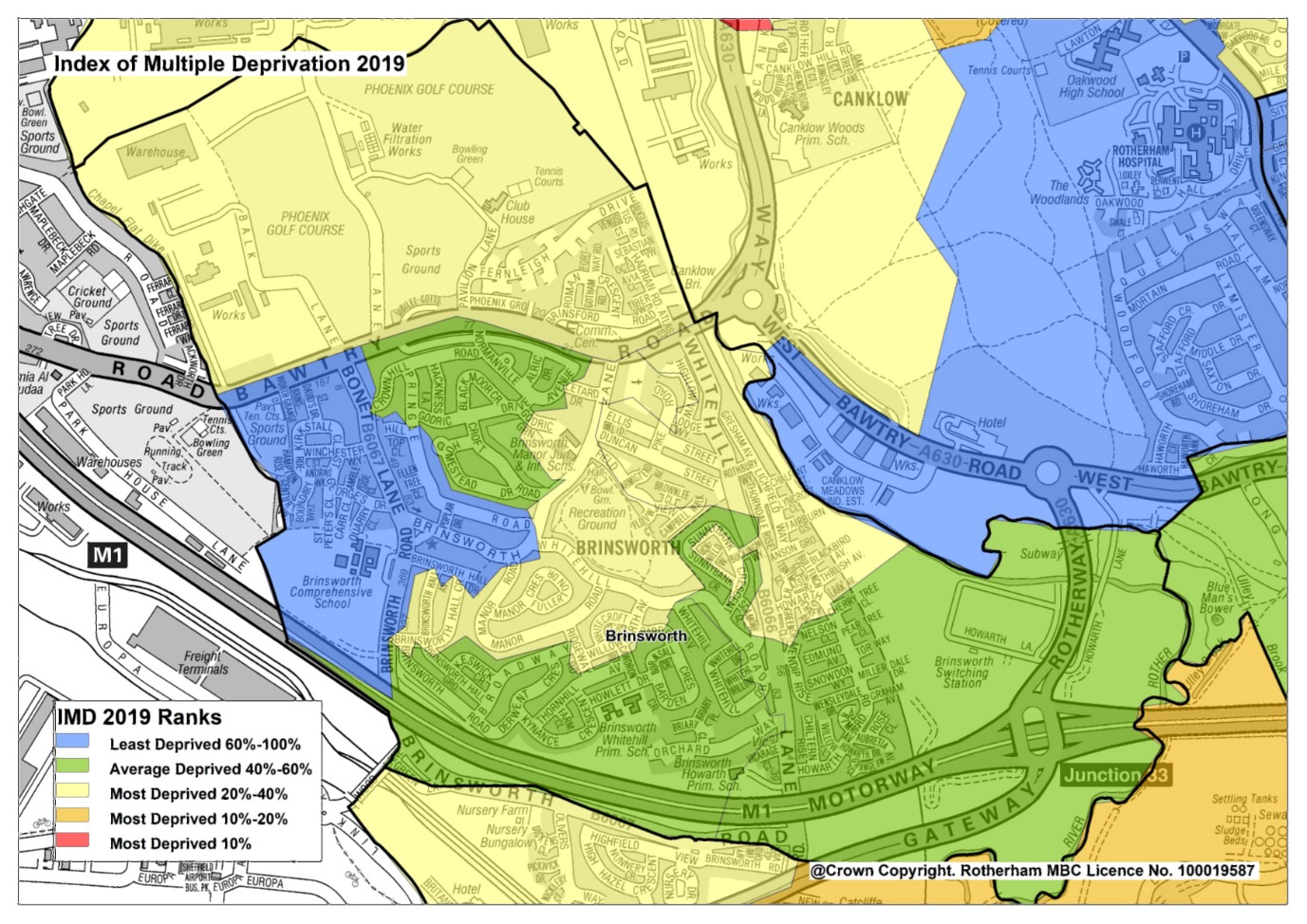Ward profile
Employment, Benefits and Pension
Lifestyles and Specific Health Issues
Crime and Anti-social Behaviour
Index of Multiple Deprivation 2015 and 2019

Description
Brinsworth ward lies in the west of Rotherham Borough, with a population of 9,527 (2021 census).
The ward is represented by two members of the Council.
Most of the population live in the parish of Brinsworth (population 9,129) with the remainder in the Phoenix area north of Bawtry Road.
Suburban housing predominates in Brinsworth and is popular with commuters to both Rotherham and Sheffield.
Junction 33 of the M1 motorway is situated in the ward.
Find out more about Brinsworth on Rotherham Data Hub.
Population
The population of Brinsworth ward has increased by 8.4% since 2011 compared to the increase in overall borough population of 3.3%. The age structure of the population is slightly older than the Rotherham average.
|
Age |
Ward Population |
Ward Percentage |
Rotherham Percentage |
|
Age 00-15 |
1608 |
16.88 |
18.89 |
|
Age 16-24 |
841 |
8.83 |
9.60 |
|
Age 25-44 |
2353 |
24.70 |
25.09 |
|
Age 45-64 |
2625 |
27.55 |
26.76 |
|
Age 65+ |
2100 |
22.04 |
19.66 |
|
Total |
9527 |
100.00 |
100.00 |
Ethnicity
Brinsworth is among the 80% of wards in Rotherham where the white British population exceeds 90%. However, the 2020 School and Pupil Census shows ethnic minority students accounting for over 10% of the school age population.
|
Ward % |
Rotherham % |
England % |
|
|
White British |
90.60 |
88.30 |
74.70 |
|
Asian/Asian British |
4.20 |
5.30 |
9.60 |
|
White Other |
1.80 |
2.80 |
6.30 |
|
Mixed/multiple |
1.30 |
1.40 |
3.00 |
|
Black/Black British |
1.20 |
1.10 |
4.20 |
|
Other |
0.90 |
1.10 |
2.20 |
Housing and Households
Total dwellings (2021 Census) - 4245
Total dwellings (2011 Census) - 3582
Change since 2011 (%) – 18.50
Number of households
Households (2021 Census) - 4134
Households (2011 Census) - 3582
Change since 2011 (%) – 15.40
Population Density (no. of residents per square Kilometre) 2021 Census
Ward – 2408.60
Rotherham - 927.70
Employment, Benefits and Pensions
In Brinsworth ward the total claimant count in July 2023 is 145, which is 2.4% of the working age population. This is lower than the Rotherham average where the claimant count is 4.3% of the working age population.
Nearly half of all jobs in Brinsworth are based in education, meaning public sector jobs in the ward are well above the borough average. Employment levels in the ward depend on opportunities in other areas as local jobs account for only 14% of local workers in 2022.
Health
In Brinsworth 42.9% are in very good health, and 1.3% are in very bad health. In comparison, in Rotherham 44.3% are in very good health and 1.6% are in very bad health.
According to Census 2021, in Brinsworth ward, 19.3% of the population are considered to be disabled under the Equality Act 2010, compared to 21.1% in Rotherham and 17.3% in England.
Life expectancy
In the period 2016-2020, Brinsworth ward's life expectancy at birth for females is 84.6 years and for males is 80.6 years. This is better than the England average. In comparison, Rotherham's life expectancy for females is 81.3 years and for males is 77.6 years.
Disease and lifestyle
In the 2016-20 time period, the mortality ratio for deaths from strokes in Brinsworth ward is 115.6. This is similar to England. In comparison, the lowest mortality ratio for stroke deaths in a Rotherham ward is 56.7 in Aston & Todwick ward and the highest ratio is 185.8 in Rother Vale ward.
In the 2016-20 time period, the mortality ratio for deaths from respiratory disease in Brinsworth ward is 90.8. This is similar to England. In comparison, the lowest mortality ratio for deaths from respiratory disease in a Rotherham ward is 79.9 in Bramley & Ravenfield ward and the highest ratio is 209.1 in Rother Vale ward.
In the 2016-20 time period, the mortality ratio for deaths from coronary heart disease in Brinsworth ward is 107.1. This is similar to England. In comparison, the lowest mortality ratio for deaths from coronary heart disease in a Rotherham ward is 76.2 in Aston & Todwick ward and the highest ratio is 152.1 in Rotherham East ward.
In the 2016-20 time period, the mortality ratio for deaths from circulatory disease in Brinsworth ward is 95. This is similar to England. In comparison, the lowest mortality ratio for deaths from circulatory disease in a Rotherham ward is 73.5 in Aston & Todwick ward and the highest ratio is 141.9 in Rother Vale ward.
In the 2016-20 time period, the mortality ratio for deaths from cancer in Brinsworth ward is 109.4. This is similar to England. In comparison, the lowest mortality ratio for deaths from cancer in a Rotherham ward is 94.2 in Aston & Todwick ward and the highest ratio is 152.1 in Rother Vale ward.
Obesity
In Brinsworth ward (for the time period 2019/20-2021/22) the percentage of children in Reception (aged 4-5 years) classified as overweight or obese is 27.3%. This is worse than the England average. The percentage of children classified as obese (including severe obesity) is 13.6%. This is worse than the England average. In Rotherham overall (for comparison) the percentage of children aged 4-5 years classified as overweight or obese is 25.1% and the percentage classified as obese (including severe obesity) is 11.4%.
In Brinsworth ward (for the time period 2019/20-2021/22) the percentage of children in Year 6 (aged 10-11 years) classified as overweight or obese is 32.1%. This is better than the England average. The percentage of children classified as obese (including severe obesity) is 18.9%. This is better than the England average. In Rotherham overall (for comparison) the percentage of children aged 10-11 years classified as overweight or obese is 38.8% and the percentage classified as obese (including severe obesity) is 25.1%.
Education
According to Census 2021, in Brinsworth ward 22.8% of residents aged 16 or over have no qualifications, and 19.9 % are qualified to level 4 or above. In comparison 23.4% in Rotherham have no qualifications and 23.1% are qualified to level 4 or above.
For Brinsworth ward in 2023, there was a total of 84 pupils at the end of key stage 2, of which 22.6% were disadvantaged compared to 54.5% for Rotherham overall. The percentage of pupils in the ward achieving the expected standard in Reading, Writing and Maths was 38.1%, compared to 54.5% in Rotherham and 59% nationally.
For Brinsworth ward in 2023, there was a total of 100 pupils at the end of key stage 4, of which 23% of pupils were disadvantaged, compared to 53.4%% in Rotherham overall. The average Attainment 8 score for the ward was 44.1, compared to 43.2 in Rotherham and 46.2 nationally.
Crime and Anti-Social Behaviour (ASB)
Levels of recorded crime and anti-social behaviour in Brinsworth ward are lower than the Rotherham average.
In Brinsworth ward in 2021 there were a total of 600 recorded crimes. This equates to 63 recorded crimes per 1,000 population compared to 110 per 1,000 population for Rotherham.
In Brinsworth ward in 2021, there were a total of 139 recorded incidents of anti-social behaviour. This equates to 15 recorded incidents per 1,000 population, compared to 19 per 1,000 population for Rotherham.
Index of Deprivation
Brinsworth ward has a rank of 19 out of 25 wards in Rotherham and is in Decile 5. Of the 25 wards in Rotherham, 5 are in the top 20% most deprived in the country (deciles 1 and 2). The top 3 most deprived wards in Rotherham are Rotherham East, Dalton & Thrybergh and Maltby East.
Deprivation in Brinsworth ward is below the borough average and in most of the ward is also well below the national average. There are no neighbourhoods within the most deprived 10% of England.
In Brinsworth ward, the proportion of all children aged 0-15 living in income deprived families is 13.7% and the proportion of those aged 60 or over who experience income deprivation is 10.4%. The ward with the highest proportion of children aged 0-15 living in income deprived families is Dalton & Thrybergh ward at 39.1%. The ward with the highest proportion of those aged 60 and over who experience income deprivation is Rotherham East ward at 36.9%.

Data Sources
Data sources contained within this document include:
Population - ONS Census data via NOMIS Ethnicity - ONS Census data via NOMIS
Religion - ONS Census data via NOMIS
Housing - ONS Census data via NOMIS
Households - ONS Census data via NOMIS
Unemployment claimants aged 16-64 - ONS Claimant Count via NOMIS
Types of employment - Business Register and Employment Survey via NOMIS
General Health - ONS Census data via NOMIS
Disability - ONS Census data via NOMIS
Life expectancy at birth - Public Health England Fingertips
Causes of death - Public Health England Fingertips
Overweight and obesity in children - Public Health England Fingertips
Highest level of education - ONS Census data via NOMIS
Key Stage 2 and Key Stage 4 attainment - RMBC Children & Young People's Services
Index of Multiple Deprivation - Ministry of Housing, Communities and Local Government Community assets map - OpenStreetMap via TomTom/Microsoft Corporation
Access to green space - Green Space Index 2023 commissioned by The Ordinance Survey and undertaken by The Fields in Trust
Crime data - www.police.uk
